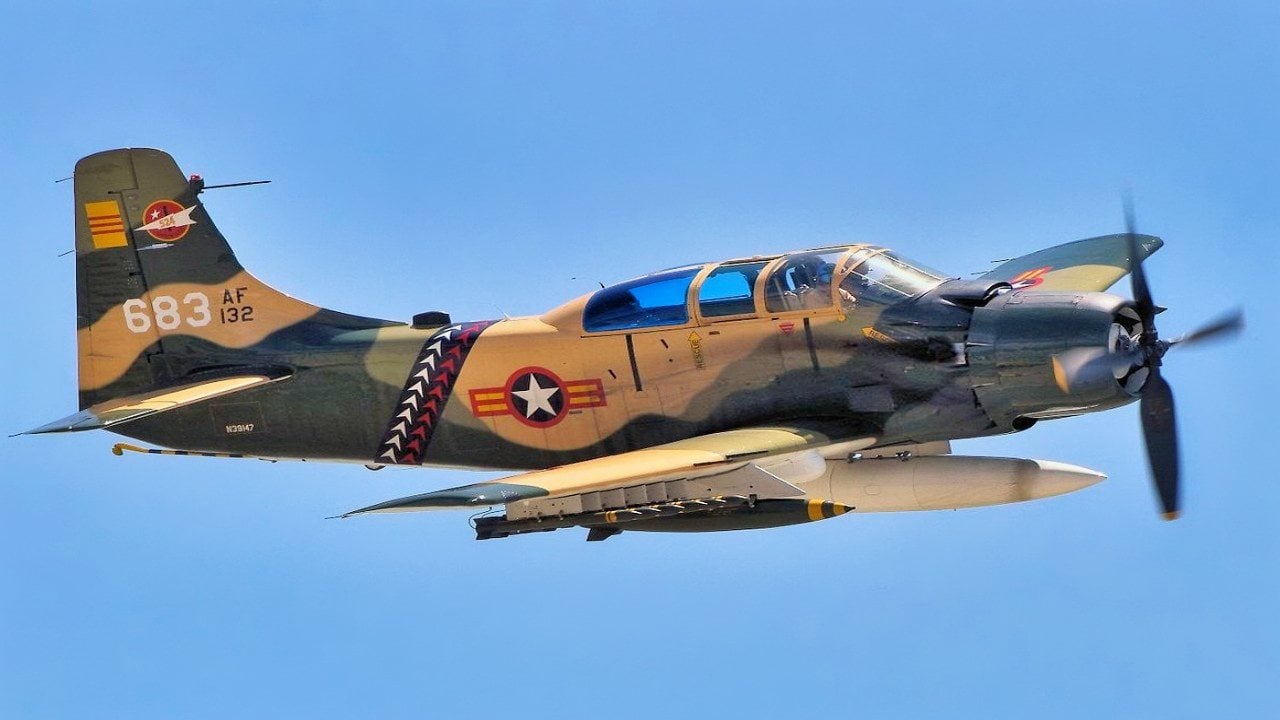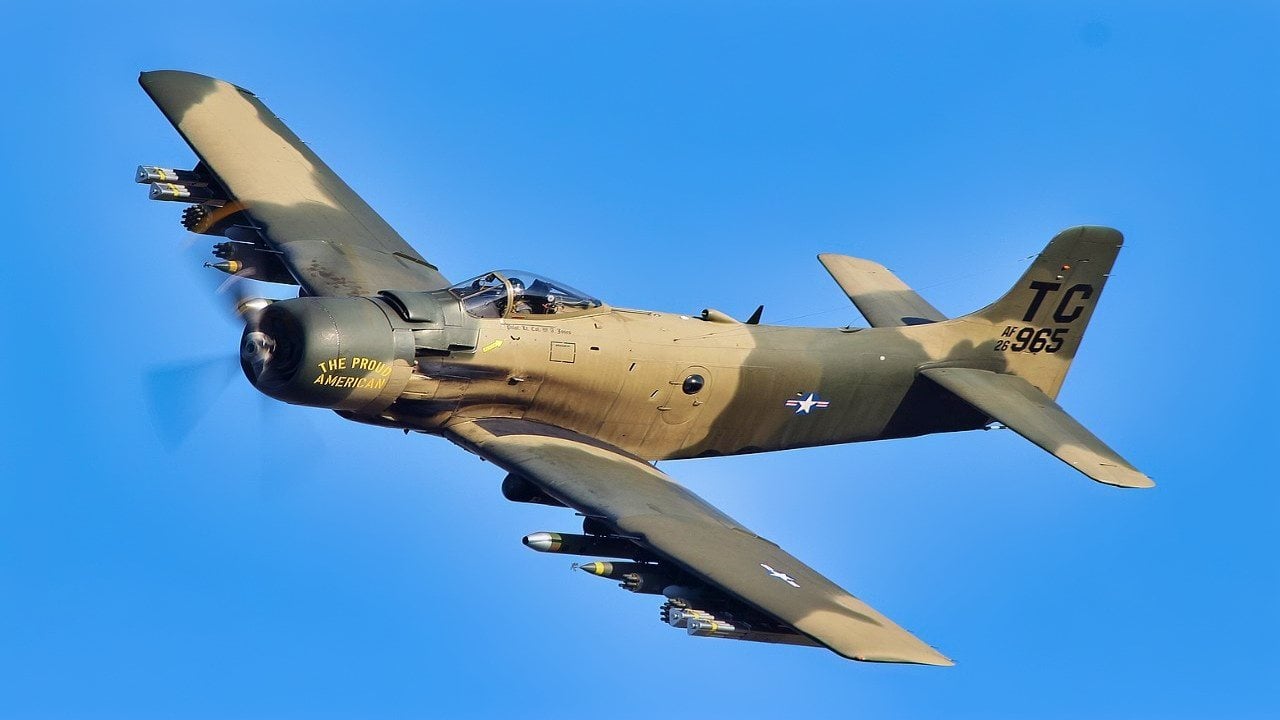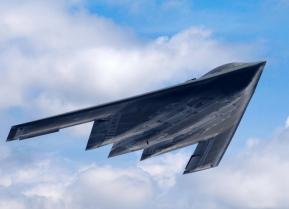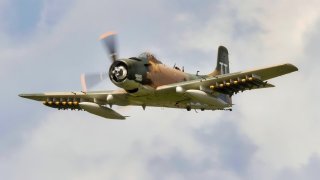A-1 Skyraider: The Prop Plane That Could Fly Nearly Any Combat Mission
The Douglas A-1/ AD-1 Skyraider made her maiden flight on 18 March 1945, i.e. whilst WWII was still raging. She would serve with distinction.
The Douglas A-1/ AD-1 Skyraider made her maiden flight on 18 March 1945, i.e. whilst WWII was still raging.
If you think she bears at least a passing resemblance to another famous warbird made by the Douglas Aircraft Company – which later became McDonnell Douglas and then in turn merged with Boeing – you’re not just hallucinating; the Skyraider is directly descended from the legendary Douglas SBD Dauntless dive bomber that absolutely ravaged Imperial Japanese shipping during WWII. Indeed, the prototype that made that aforementioned maiden flight was initially designated the XBT2D-1 Dauntless II.
However, by the time the final product was delivered to the U.S. Navy in December 1946, for whatever reason the official moniker was changed to Skyraider. (Seeing as how the original Dauntless is my favorite WWII airplane, that bums me out just slightly.)
The A-1 soon found herself adopted by the U.S. Air Force and Marine Corps, as well as the British Royal Navy Fleet Air Arm, the French Air Force, and Republic of Vietnam Air Force (RVNAF). The plane sported a fuselage length of 38 feet 10 inches, a wingspan of 50 feet, and a height of 15 feet 8.25 inches. Empty weight was 12,094 pounds, with a maximum takeoff weight of 25,000 pounds. The single 2,700 horsepower Wright R-3350-26W engine churned out a max airspeed of 343 miles per hour at 20,000 feet. Armament consisted of four 20mm fixed forward-firing cannon and 8,000 lb. of ordnance.
Triple-S: from “Skyraider” to “Spad” to “Sandy”
When the Korean War beckoned, the Skyraider was there to answer the call the duty. As noted by the National Naval Aviation Museum info page: “The ‘Able Dog’ or ‘Spad,’ as the Skyraider was called, earned its stellar reputation as one of the finest attack aircraft ever built in the skies over Korea.
Their missions were varied, from attacking heavily defended industrial targets like power plants and bridges to knocking out the Hwachon Dam with aerial torpedoes to earning the affection of many a grunt with its close air support capabilities. Operations in Korea also reflected the versatility of the Skyraider, the platform modified to conduct a host of missions including electronic countermeasures and night attack….In the years following the Korean War…(s)ome AD pilots trained for the possibility of nuclear war, flying so-called Sandblower missions, long-range flights to deliver nuclear bombs at low altitude that involved such an extended amount of time in the cockpit that aviators nicknamed them ‘Butt Busters.’”
That ‘Spad’ moniker was in honor of the French fighter plane of the First World War. It was during the heady days of the Vietnam War that the Skyraider would earn its other famous unofficial sobriquet: “Sandy.”
By the time America’s air campaign in Vietnam kicked off in earnest in 1964, a different Douglas-built warbird, the A-4 Skyhawk, increasingly the mainstay of the Navy’s carrier-based attack arsenal, but the tenacious ol’ A-1 still managed to cement her place in Naval Aviation history by participating in the first strikes against North Vietnam in response to the Tonkin Gulf Incident in August 1964, the Navy continued flying attack missions with the “Spad” until 1968.
Meanwhile, the U.S. Air Force employed the A-1 on combat search and rescue and air commando missions, as dramatized in the 1991 motion picture Flight of the Intruder – in turn based upon the bestselling novel by Stephen Coonts.
It was during these CSAR missions that the “Sandy” moniker came into being, as recounted by Dario Leone of The Aviation Geek Club:
“As explained by Wayne Mutza in his book The A-1 Skyraider in Vietnam, the famous callsign ‘Sandy’ was founded in late 1965 by Capt. J.W. ‘Doc’ George during an A-1 replacement flight to one of the several A-1 groups that rotated through Udorn. Actually it was George’s Bine Hoa departure callsign. After having landed at Udorn he was asked what call sign he would like to use while there. George's answer was ‘Sandy.’ Not only was the callsign retained by George’s replacement, but also became the callsign of any Skyraider assigned the SAR mission.”
The following year, “Sandy,” or more accurately a “Sandy” driver, would earn an ever greater distinction than a cute callsign, that being the Medal of Honor: on 19 March 1966, Major Bernard Fisher rescued a fellow pilot shot down over South Vietnam by landing in enemy territory under heavy fire and flying him to safety.
A-1 Skyraider: Where Are They Now?
A total of 3,180 Skyraiders were built between 1945 and 1967. They were retired from U.S. military service in 1973, but the Gabonese Air Force/Armée de l'air Gabonaise kept them in service until 1985.

Roughly 15 airworthy Skyraiders survive today, including specimens based at the Warbird Heritage Foundation in Waukegan, Ill, and the Military Aviation Museum in Virginia Beach, Virginia. Meanwhile, there are roughly double that number of airframes on static display status; the “Sandy” flown by Maj. Fisher on his MOH-winning mission, serial number 52-132649, is housed within the Southeast East War Gallery of the National Museum of the United States Air Force at Wright-Patterson AFB (in the vicinity of Dayton), Ohio.

About the Author
Christian D. Orr is a former Air Force Security Forces officer, Federal law enforcement officer, and private military contractor (with assignments worked in Iraq, the United Arab Emirates, Kosovo, Japan, Germany, and the Pentagon). Chris holds a B.A. in International Relations from the University of Southern California (USC) and an M.A. in Intelligence Studies (concentration in Terrorism Studies) from American Military University (AMU). He has also been published in The Daily Torch and The Journal of Intelligence and Cyber Security. Last but not least, he is a Companion of the Order of the Naval Order of the United States (NOUS).


